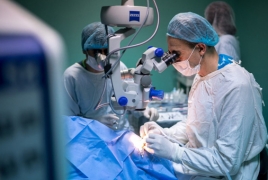Armenian EyeCare Project responds to heightened needs after war August 19, 2021 - 14:54 AMT PanARMENIAN.Net - Due to the immense support from dedicated donors as well as organizations like UCLA’s Operation Armenia, the Armenian EyeCare Project (AECP) has been able to meet the increased need for vision care in post-war Armenia through both emergency relief efforts following the attack and ongoing relief programs that continue to offer care for those who need it, the Armenian Weekly reports. It has been nearly a year since Azerbaijan’s attack on Artsakh –– an ethnic enclave home to hundreds of thousands of Armenians –– and much has changed in that time. What began as an attack targeting innocent civilians in their homes, businesses, schools, churches and hospitals ultimately led to war as it propelled Armenia’s military to act. Over 5,000 Armenian soldiers were killed, countless more were wounded, and more than half of the civilian population of Artsakh (Nagorno-Karabakh) has been displaced from their homes as they seek refuge in Armenia. The efforts have included urgent treatment for wounded soldiers and civilians during and after the war through the launch of the AECP’s Vision Referral Program to most efficiently care for those injured and the expansion of the AECP’s Low Vision Center to offer aid to the increased number of Armenians with vision loss. With resounding support from donors and unwavering commitment from its doctors and staff, the AECP was able to offer a coordinated response just days after the war began, utilizing its established infrastructure, equipped clinics and trained medical staff. In addition to treating immediate eye trauma, the AECP quickly realized that many soldiers wounded in the war would need long-term, follow-up care to recover their sight, including orbital implants and ongoing assistance at the AECP’s Low Vision Center. With this in mind, the AECP launched a Vision Referral Program, facilitating the highest quality eye care by connecting specialists in Armenia and abroad to discuss cases and offer the best treatment solutions. This effort has largely been made possible thanks to the generous support of UCLA’s Operation Armenia, which is a coordinated endeavor under the umbrella of The Promise Armenian Institute at UCLA and implemented through the advocacy of UCLA Health, to provide immediate medical disaster relief and long-term humanitarian aid and support to Artsakh and Armenia. As the need for vision care in Armenia increases due to injuries sustained by soldiers and civilians as a result of the war, the AECP has established a Vision Referral Program to effectively address this heightened demand. Blast burns, explosion debris and white phosphorus have been just some of the ways the wounded have been hurt and the majority of those affected have been Armenia’s soldiers, though some civilians have been injured too. As a result of floods in Armenia’s northern Lori and Tavush provinces, 17 bridges, including five large ones, have collapsed. David Vardanyan is the son of former Karabakh leader Ruben Vardanyan who who is currently imprisoned in Azerbaijan. Prime Minister Nikol Pashinyan has met with Stephan Schütz, Executive Partner at Gerkan, Marg and Partners. The number of state universities will be reduced from 23 to 8 by 2030, Minister of Education, Science, Culture and Sport Zhanna Andreasyan has said. Partner news |